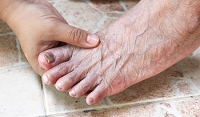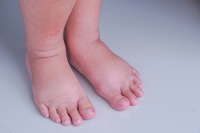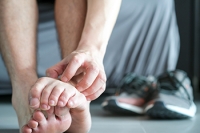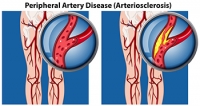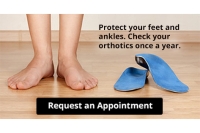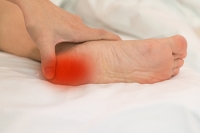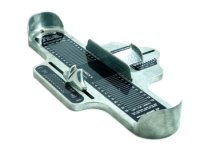
Blog (730)
Changes to Your Feet as You Age
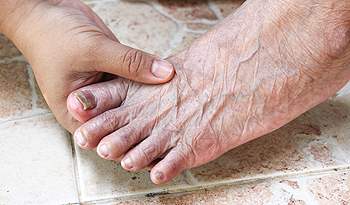
As people age, the body undergoes numerous changes, and changes to the feet are no exception. First, the skin becomes thinner, and you may notice joint pain you never had before from simple wear and tear. In addition, the muscles become weaker and less resilient. All this adds up to not being able to do many of the things that you used to do, or doing them more slowly and for shorter periods of time. Added to simply aging, certain conditions such as neuropathy, circulatory issues, and swelling of the feet (edema) may bring additional pain and increase the risk of injury or falling. The bones also begin to lose density, adding to the risk of fractures, especially in post-menopausal women. The fat pads in the heels and soles of the feet diminish, which may lead to such painful conditions as plantar fasciitis. Arthritis, an inflammation of the joints, may develop, causing more pain. Ways to stave off some of the effects of aging feet include finding footwear that fits properly and provides extra cushioning. Also, it is thought that foot and toe stretches help to keep the blood circulating and prevent swelling. Keeping your feet clean, dry, and moisturized can help you avoid infections. And watching your weight is important, as extra weight increases the load your feet have to support each time you take a step. For more information on taking care of your feet during your older years, please consult a podiatrist.
Proper foot care is something many older adults forget to consider. If you have any concerns about your feet and ankles, contact Dr. Kenneth Donovan from Advanced Care Foot and Ankle. Our doctor can provide the care you need to keep you pain-free and on your feet.
The Elderly and Their Feet
As we age we start to notice many changes in our body, but the elder population may not notice them right away. Medical conditions may prevent the elderly to take notice of their foot health right away. Poor vision is a lead contributor to not taking action for the elderly.
Common Conditions
- Neuropathy – can reduce feeling in the feet and can hide many life-threatening medical conditions.
- Reduced flexibility – prevents the ability of proper toenail trimming, and foot cleaning. If left untreated, it may lead to further medical issues.
- Foot sores – amongst the older population can be serious before they are discovered. Some of the problematic conditions they may face are:
- Gouging toenails affecting nearby toe
- Shoes that don’t fit properly
- Pressure sores
- Loss of circulation in legs & feet
- Edema & swelling of feet and ankles
Susceptible Infections
Diabetes and poor circulation can cause general loss of sensitivity over the years, turning a simple cut into a serious issue.
If you have any questions please feel free to contact one of our offices located in Warren, Livingston, and Toms River, NJ . We offer the newest diagnostic and treatment technologies for all your foot and ankle needs.
Various Reasons for Swollen Feet
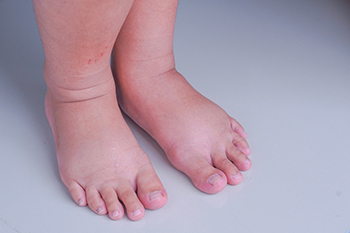
Many people have swollen feet and it is a rather common condition. It is easily noticed and can be uncomfortable. An injury is a common cause of this ailment which may disappear after the injury has healed. Additionally, there may be underlying health conditions that may cause the feet to swell and it can be a reason to seek prompt medical attention. Many pregnant women experience swollen feet, which is known as edema. Relief can come from frequently elevating the feet and from reducing salt intake. Various lifestyle factors may contribute to the development of swollen feet including sitting down for the majority of the day, wearing shoes that do not fit correctly, and being overweight. Edema may happen as a side effect of taking certain medications including antidepressants, hormones, or blood pressure medications. Many people have found effective methods that can help to control swollen feet. These can consist of drinking fresh water daily, staying active, losing an appropriate amount of weight, and consuming a healthy diet. If you suffer from swollen feet and would like to be properly diagnosed, please consult with a podiatrist who can guide you toward the correct treatment options.
Swollen feet can be a sign of an underlying condition. If you have any concerns, contact Dr. Kenneth Donovan of Advanced Care Foot and Ankle. Our doctor can provide the care you need to keep you pain-free and on your feet.
Swollen feet are a common ailment among pregnant women and people who stand or sit for extended periods. Aging may increase the possibility of swollen feet and patients who are obese often notice when their feet are swelling too. There may be medical reasons why swollen feet occur:
- Phlebitis - A condition that causes the veins to become inflamed and can also cause leg pain.
- Liver disease - This may lead to low blood levels of albumin which is a protein. This can cause fluid in the blood to pass into the tissues and several areas of the body can become swollen.
- Heart failure - When the heart doesn’t pump properly the blood that is normally pumped back to the heart can pool in the veins of the legs causing swollen feet.
- Kidney disease - One of the main functions of the kidneys is releasing excess fluid in the body. This type of condition can make it difficult for the kidneys to function properly, and as a result the feet may become swollen.
- Deep-vein thrombosis (DVT)- This is a serious condition where blood clots form in the veins of the legs. They can block the return of blood from the legs to the heart which may cause the feet to swell. It is important to be treated by a podiatrist if this condition is present.
Swollen feet can also be caused by bone and tendon conditions, including fractures, arthritis, and tendinitis. Additionally, there may be skin and toenail conditions and an infection may cause the feet to swell. Patients who take medicine to treat high blood pressure may be prone to getting swollen feet.
Many patients elevate their feet to help relieve the swelling and this is generally a temporary remedy. When a podiatrist is consulted the reason behind the swelling can be uncovered and subsequently treated.
If you have any questions please feel free to contact one of our offices located in Warren, Livingston, and Toms River, NJ . We offer the newest diagnostic tools and technology to treat your foot and ankle needs.
Heel Pain Can Be Treated!
What Are Risk Factors for Athlete’s Foot?
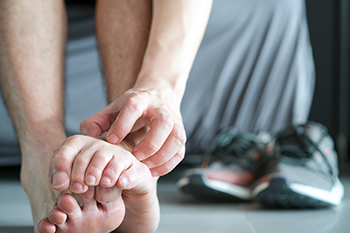
Athlete’s foot is a pesky affliction of the foot that you may experience at some point in your life. The condition is a kind of fungal infection that is spread in warm, moist environments. Most typically, athlete’s foot can be spread to someone when they walk barefoot in highly-trafficked public areas where the fungus is present such as pool sides and locker rooms. There are several risk factors associated with athlete’s foot. First, if you are someone who usually wears damp or tight-fitting shoes, socks, or stockings, then you are increasing your risk of developing athlete’s foot. Wearing this kind of shoe or sock for prolonged periods can essentially trap the fungus, enabling it to thrive and wreak havoc on your feet. Additionally, if you are someone who suffers from persistently sweaty feet, then you may be at a greater risk of developing athlete’s foot. Those with conditions such as HIV-AIDS who have impaired immune systems are also particularly susceptible to suffering from athlete’s foot, as such individuals have a difficult time fighting off the fungus. If you identify with any of these risk factor groups, it might be a good idea to contact a podiatrist who can help ward off athlete’s foot.
Athlete’s foot is an inconvenient condition that can be easily reduced with the proper treatment. If you have any concerns about your feet and ankles, contact Dr. Kenneth Donovan from Advanced Care Foot and Ankle. Our doctor will treat your foot and ankle needs.
Athlete’s Foot: The Sole Story
Athlete's foot, also known as tinea pedis, can be an extremely contagious foot infection. It is commonly contracted in public changing areas and bathrooms, dormitory style living quarters, around locker rooms and public swimming pools, or anywhere your feet often come into contact with other people.
Solutions to Combat Athlete’s Foot
- Hydrate your feet by using lotion
- Exfoliate
- Buff off nails
- Use of anti-fungal products
- Examine your feet and visit your doctor if any suspicious blisters or cuts develop
Athlete’s foot can cause many irritating symptoms such as dry and flaking skin, itching, and redness. Some more severe symptoms can include bleeding and cracked skin, intense itching and burning, and even pain when walking. In the worst cases, Athlete’s foot can cause blistering as well. Speak to your podiatrist for a better understanding of the different causes of Athlete’s foot, as well as help in determining which treatment options are best for you.
If you have any questions please feel free to contact one of our offices located in Warren, Livingston, and Toms River, NJ . We offer the newest diagnostic and treatment technologies for all your foot and ankle needs.
Risk Factors and Symptoms of Peripheral Artery Disease
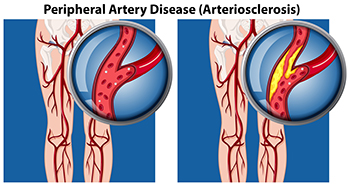
About 6.5 million people in the United States over the age of 40 have peripheral artery disease (PAD). It is a blockage in the arteries that supply blood to the extremities, but the condition is more common in the feet and lower limbs. Risk factors for peripheral artery disease include smoking, high blood pressure, diabetes, atherosclerosis, and high cholesterol. People over 60 are at further risk. The most common symptom of PAD is pain in the legs while active, but that subsides after resting. Sores in the legs or feet that don’t heal and cold or numb toes are other symptoms as well. If you believe you may have PAD, please consult a podiatrist for an examination and testing.
Peripheral artery disease can pose a serious risk to your health. It can increase the risk of stroke and heart attack. If you have symptoms of peripheral artery disease, consult with Dr. Kenneth Donovan from Advanced Care Foot and Ankle. Our doctor will assess your condition and provide you with quality foot and ankle treatment.
Peripheral artery disease (PAD) is when arteries are constricted due to plaque (fatty deposits) build-up. This results in less blood flow to the legs and other extremities. The main cause of PAD is atherosclerosis, in which plaque builds up in the arteries.
Symptoms
Symptoms of PAD include:
- Claudication (leg pain from walking)
- Numbness in legs
- Decrease in growth of leg hair and toenails
- Paleness of the skin
- Erectile dysfunction
- Sores and wounds on legs and feet that won’t heal
- Coldness in one leg
It is important to note that a majority of individuals never show any symptoms of PAD.
Diagnosis
While PAD occurs in the legs and arteries, Podiatrists can diagnose PAD. Podiatrists utilize a test called an ankle-brachial index (ABI). An ABI test compares blood pressure in your arm to you ankle to see if any abnormality occurs. Ultrasound and imaging devices may also be used.
Treatment
Fortunately, lifestyle changes such as maintaining a healthy diet, exercising, managing cholesterol and blood sugar levels, and quitting smoking, can all treat PAD. Medications that prevent clots from occurring can be prescribed. Finally, in some cases, surgery may be recommended.
If you have any questions, please feel free to contact one of our offices located in Warren, Livingston, and Toms River, NJ . We offer the newest diagnostic and treatment technologies for all your foot care needs.
How Your Weight May Affect Swelling in Your Feet
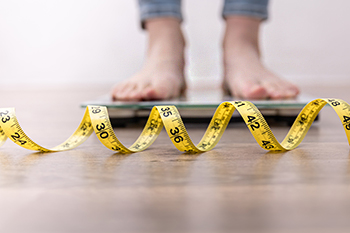
Being overweight or obese can cause a variety of health problems, including issues with your feet and ankles. Extra pounds can mean extra pressure placed on these areas, which may lead to foot pain, plantar fasciitis, arthritis, flat feet, and peripheral edema. Peripheral edema is the medical term for swelling in the feet, ankles, and lower legs. The swelling occurs when there is decreased blood circulation caused by excess body mass which, in turn, leads to an accumulation of fluid in the tissues. Peripheral edema may sometimes be prevented by exercising regularly, reducing salt consumption, and achieving/maintaining a healthier body weight. A podiatrist can provide additional prevention tips for peripheral edema, and use a variety of methods to treat it.
The more you weigh, the harder your feet must work to support your body. If you’re an obese individual and are concerned about your feet, contact Dr. Kenneth Donovan from Advanced Care Foot and Ankle. Our doctor can provide the care you need to keep you pain-free and on your feet.
Obesity and Your Feet
People who are overweight are putting more pressure on their ankles, knees, and hips as well as their feet. This unfortunately can lead to variety of different issues.
Problems & Complications Stemming from Obesity
- When the body is overweight, it tries to compensate by changing the way that it moves. An obese person may lean forward and put extra weight on the wrong part of the foot. This puts unnecessary stress on the feet.
- Obese people are also more likely to develop type II diabetes which is a condition that causes a lot of foot problems. People with diabetes often don’t feel the cuts and sores that they may have on their feet, which can lead to more complicated and severe issues.
- Plantar fasciitis is another foot condition that can be caused by obesity. Plantar fasciitis is an inflammation of the tissue along the bottom of the foot, which causes pain and stiffness while walking and climbing stairs.
If you have any questions, please feel free to contact one of our offices located in Warren, Livingston, and Toms River, NJ . We offer the newest diagnostic and treatment technologies for all your foot care needs.
Reminder: When Was the Last Time...?
Truck Driving and Plantar Fasciitis
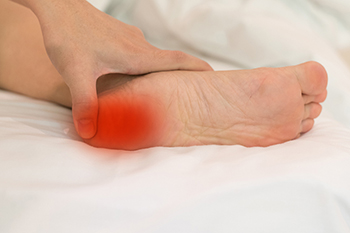
One of the most common causes of heel pain is a condition known as plantar fasciitis. This condition is caused by the straining of the ligament that runs between the toes and the heel. The straining of this ligament can produce sharp and shooting pains in the bottom of the feet that are most prominent when taking your first step after a prolonged period of rest. Many individuals are at a higher risk of suffering from plantar fasciitis. Namely, women who often wear high-heeled shoes are more prone to experiencing plantar fasciitis because of the extra strain that such footwear causes on the heel. However, it may come as a surprise to some that truck drivers are also at a greater risk of experiencing this condition. This can be explained by the fact that truck drivers spend most of their day sitting while driving, but often must suddenly and sporadically engage in physical activity during rest stops before they can properly stretch and re-engage ligaments in their feet. Truck drivers may be able to stave off the effects of plantar fasciitis by regularly stretching foot ligaments and muscles, especially before beginning to walk after a long drive. Truck drivers may also consider opting for more supportive footwear or wearing a heel cup for extra protection. Although some occupations may put individuals at a greater risk of developing plantar fasciitis, a podiatrist may be able to help create a plan to remedy and prevent this condition.
Plantar fasciitis can be very painful and inconvenient. If you are experiencing heel pain or symptoms of plantar fasciitis, contact Dr. Kenneth Donovan from Advanced Care Foot and Ankle. Our doctor can provide the care you need to keep you pain-free and on your feet.
What Is Plantar Fasciitis?
Plantar fasciitis is the inflammation of the thick band of tissue that runs along the bottom of your foot, known as the plantar fascia, and causes mild to severe heel pain.
What Causes Plantar Fasciitis?
- Excessive running
- Non-supportive shoes
- Overpronation
- Repeated stretching and tearing of the plantar fascia
How Can It Be Treated?
- Conservative measures – anti-inflammatories, ice packs, stretching exercises, physical therapy, orthotic devices
- Shockwave therapy – sound waves are sent to the affected area to facilitate healing and are usually used for chronic cases of plantar fasciitis
- Surgery – usually only used as a last resort when all else fails. The plantar fascia can be surgically detached from the heel
While very treatable, plantar fasciitis is definitely not something that should be ignored. Especially in severe cases, speaking to your doctor right away is highly recommended to avoid complications and severe heel pain. Your podiatrist can work with you to provide the appropriate treatment options tailored to your condition.
If you have any questions please feel free to contact one of our offices located in Warren, Livingston, and Toms River, NJ . We offer the newest diagnostic and treatment technologies for all your foot and ankle needs.
Two Methods of Measuring Feet
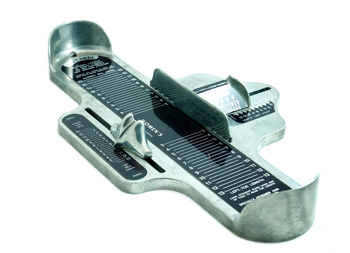
The importance of knowing your correct shoe size before making a purchase is crucial for the health of your feet. The majority of shoe stores have an object known as the Brannock device, which can accurately measure your shoe size. Additionally, if you choose to measure your feet at home there is a simple procedure that can accomplish this. It is important to wear the socks that would normally be worn with the shoes, followed by taping a piece of paper to the floor directly under a wall. After stepping on the paper, trace the outline of your foot. The next step is to measure the length of the foot and this will tell you your shoe size. It is suggested to try on both shoes at the end of the day when the feet are at their largest. A comfortable fit is crucial from the beginning and research has shown that shoes should not have to be broken in. There are also different types of footwear for various sports. If you would like more information about what type of shoes to buy, please confer with a podiatrist who can answer any questions you may have.
Getting the right shoe size is an important part of proper foot health. Seek the assistance of Dr. Kenneth Donovan from Advanced Care Foot and Ankle. Our doctor will provide the care you need to keep you pain-free and on your feet.
Getting the Right Shoe Size
There are many people who wear shoes that are the incorrect size, negatively affecting their feet and posture. Selecting the right shoes is not a difficult process, so long as you keep several things in mind when it comes to choosing the right pair.
- When visiting the shoe store, use the tools available to measure your foot.
- Be sure there is ‘wiggle room’. There should be about an inch between your toes and the tip of your shoes.
- Do not always assume you are the same size, as manufacturers run differently.
- Purchase shoes later in the day, as your feet swell as the day progresses.
- If a shoe is not comfortable, it is not suitable. Most shoes can’t be ‘broken in’, and comfort should be the ultimate goal when it comes to choosing the right pair of shoes
As our feet hold our body weight and keep us moving, it is important to treat them right. Picking the right pair of shoes can provide your feet comfort and mobility without pain.
If you have any questions, please feel free to contact one of our offices located in Warren, Livingston, and Toms River, NJ . We offer the newest diagnostic and treatment technologies for all your foot care needs.
Foot Conditions in Children

Most children are born with flat feet and the arch will eventually develop. Several foot conditions may affect children in addition to having flat feet. Some children are born with bow legs, which is often noticeable as the leg below the knee bends outward. Research has indicated it often corrects itself as the growing process occurs. Pigeon toes, which are also known as in-toeing, are prevalent among babies and will begin to diminish as standing and walking begin. The opposite condition called out-toeing can be a common ailment and will correct itself as the child grows older. Many children walk on their toes as they learn how to walk and the body will eventually outgrow this too. Children between the ages of three and six may experience knock knees but treatment is rarely needed. If you notice that your child is experiencing any of these conditions, it is suggested that you consult with a podiatrist who can provide the treatment that is needed.
Making sure that your children maintain good foot health is very important as they grow. If you have any questions, contact Dr. Kenneth Donovan of Advanced Care Foot and Ankle. Our doctor can provide the care you need to keep you pain-free and on your feet.
Keeping Children's Feet Healthy
Having healthy feet during childhood can help prevent medical problems later in life, namely in the back and legs. As children grow, their feet require different types of care. Here are some things to consider...
Although babies do not walk yet, it is still very important to take care of their feet.
Avoid putting tight shoes or socks on his or her feet.
Allow the baby to stretch and kick his or her feet to feel comfortable.
As a toddler, kids are now on the move and begin to develop differently. At this age, toddlers are getting a feel for walking, so don’t be alarmed if your toddler is unsteady or ‘walks funny’.
As your child gets older, it is important to teach them how to take care of their feet.
Show them proper hygiene to prevent infections such as fungus.
Be watchful for any pain or injury.
Have all injuries checked by a doctor as soon as possible.
Comfortable, protective shoes should always be worn, especially at play.
If you have any questions please feel free to contact one of our offices located in Warren, Livingston, and Toms River, NJ . We offer the newest diagnostic and treatment technologies for all your foot and ankle needs.
